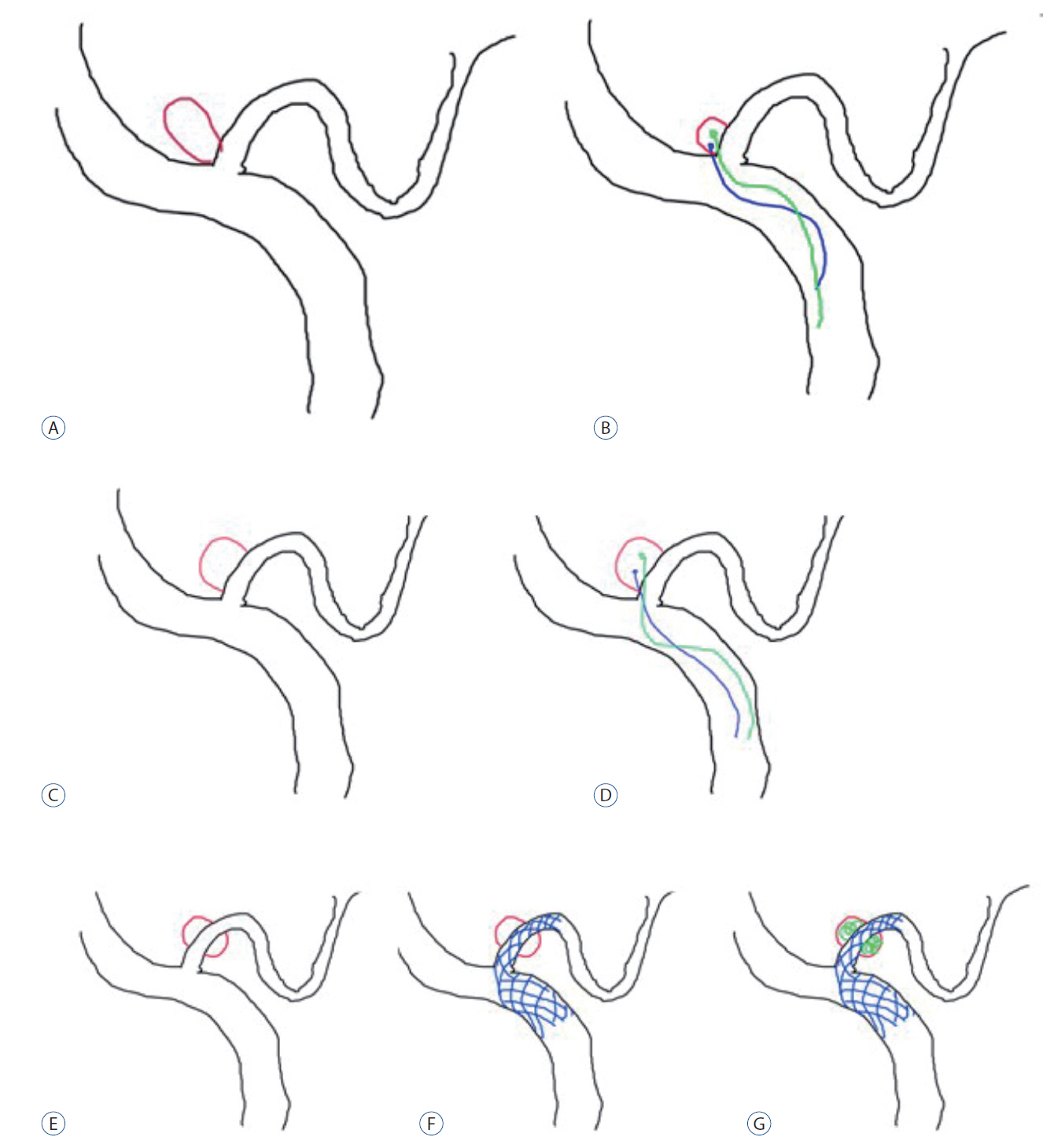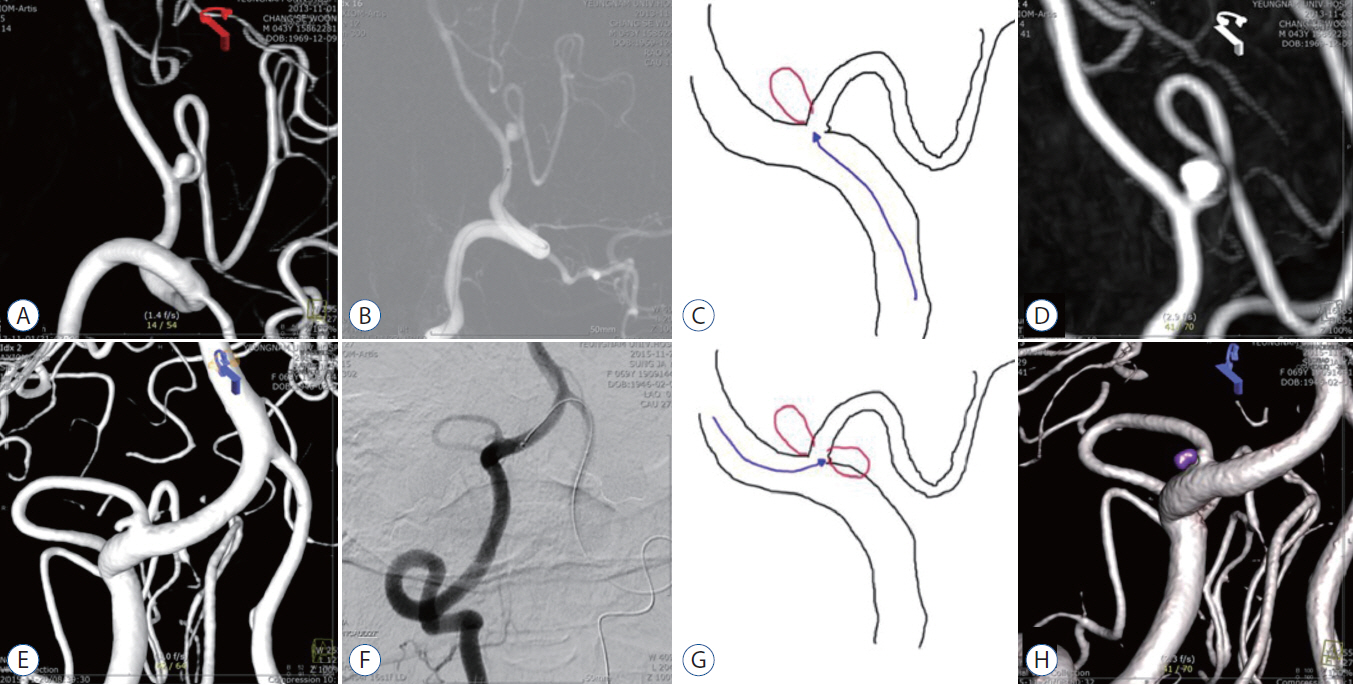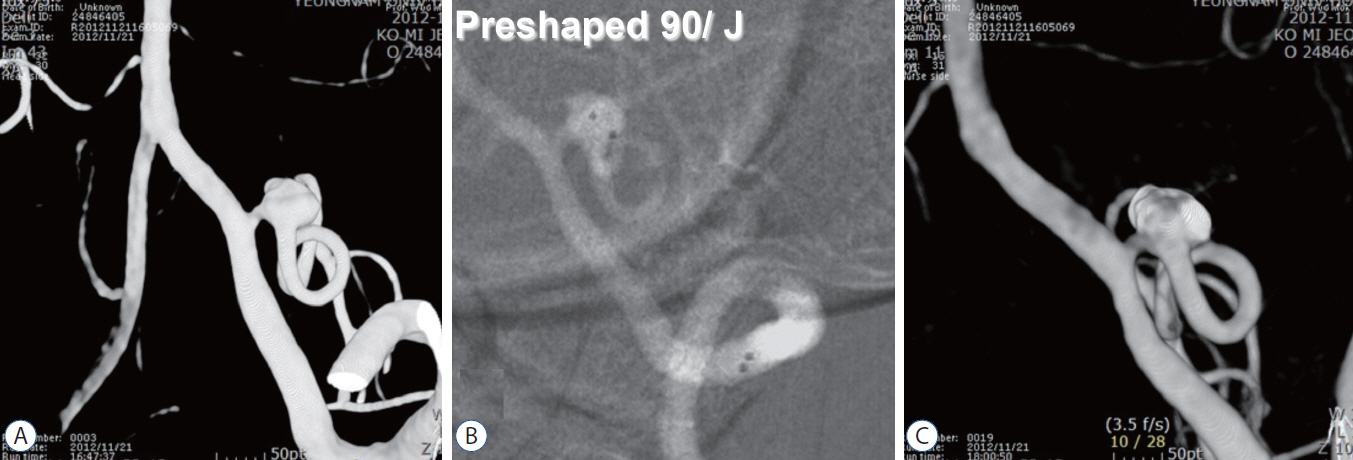J Korean Neurosurg Soc.
2018 Sep;61(5):653-659. 10.3340/jkns.2017.0229.
Technical Consideration for Coiling of Ruptured Proximal Posterior Inferior Cerebellar Artery Aneurysm
- Affiliations
-
- 1Department of Neurosurgery, Yeungnam University Medical Center, Yeungnam University Medical School, Daegu, Korea. sofesofe@hanmail.net
- KMID: 2420075
- DOI: http://doi.org/10.3340/jkns.2017.0229
Abstract
OBJECTIVE
Surgical obliteration of ruptured aneurysm of the proximal posterior inferior cerebellar artery (PICA) is challenging because of limited surgical accessibility. In recent years, coil embolization is the first-choice treatment for these lesions. However, coil embolization is not always easy in ruptured PICA aneurysm owing to the variable anatomical diversity of its shapes, its relationship to the parent artery, its low incidence, and accordingly, lesser neurointerventionist experience.
METHODS
The parent artery and microcatheter for easier navigation and the embolization technique for stable coiling were identified.
RESULTS
This study aimed to identify the more appropriate approach route, microcatheter, and strategies for an easier and safer, and more durable coil embolization in the treatment of lesions in the proximal PICA.
CONCLUSION
Coil embolization for aneurysmal subarachnoid hemorrhage due to a ruptured proximal PICA remains a challenge, but with the appropriate coiling plan, it can be treated successfully.
Keyword
MeSH Terms
Figure
Reference
-
References
1. Al-khayat H, Al-Khayat H, Beshay J, Manner D, White J. Vertebral artery-posteroinferior cerebellar artery aneurysms: clinical and lower cranial nerve outcomes in 52 patients. Neurosurgery. 56:2–0. discussion 11. 2005.
Article2. Bohnstedt BN, Ziemba-Davis M, Edwards G, Brom J, Payner TD, Leipzig TJ, et al. Treatment and outcomes among 102 posterior inferior cerebellar artery aneurysms: a comparison of endovascular and microsurgical clip ligation. World Neurosurg. 83:784–793. 2015.
Article3. Connolly ES Jr, Rabinstein AA, Carhuapoma JR, Derdeyn CP, Dion J, Higashida RT, et al. Guidelines for the management of aneurysmal subarachnoid hemorrhage: a guideline for healthcare professionals from the American Heart Association/American Stroke Association. Stroke. 43:1711–1737. 2012.
Article4. Jeon SG, Kwon DH, Ahn JS, Kwun BD, Choi CG, Jin SC. Detachable coil embolization for saccular posterior inferior cerebellar artery aneurysms. J Korean Neurosurg Soc. 46:221–225. 2009.
Article5. Park JS, Lee TH, Seo EK, Cho YJ. Aneurysms of distal posterior inferior cerebellar artery. J Korean Neurosurg Soc. 44:205–210. 2008.
Article6. Peluso JP, van Rooij WJ, Sluzewski M, Beute GN, Majoie CB. Posterior inferior cerebellar artery aneurysms: incidence, clinical presentation, and outcome of endovascular treatment. AJNR Am J Neuroradiol. 29:86–90. 2008.
Article
- Full Text Links
- Actions
-
Cited
- CITED
-
- Close
- Share
- Similar articles
-
- Aneurysm of the Posteior Inferior Cerebellar Artery Associated with Arteriovenous Malformation: Case Report
- Stent-Jack Technique for Ruptured Vertebral Artery Dissecting Aneurysm Involving the Origin of Posterior Inferior Cerebellar Artery
- Double Stent Assist Coiling of Ruptured Large Saccular Aneurysm in Proximal Basilar Artery Fenestration
- Coil Embolization of Ruptured Proximal Posterior Inferior Cerebellar Artery Aneurysm with Contralateral Retrograde Approach for LVIS Jr. Intraluminal Support Deployment
- Medial Trunk Aneurysm of the Distal Posterior Inferior Cerebellar Artery in the Fourth Ventricle: Case Report







